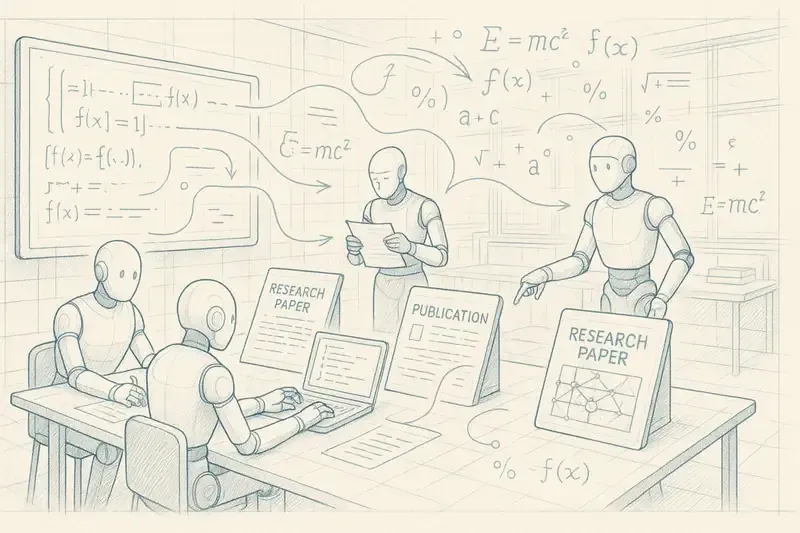
Here are the top 5 most relevant AI papers from arXiv week 41/2025, complete with analysis and insights.
Publications at a Glance
Decoding Emotion in the Deep: A Systematic Study of How LLMs Represent, Retain, and Express Emotion Jingxiang Zhang, Lujia Zhong | 10/5/2025
FaithCoT-Bench: Benchmarking Instance-Level Faithfulness of Chain-of-Thought Reasoning Xu Shen, Song Wang, Zhen Tan, Laura Yao, Xinyu Zhao, Kaidi Xu, Xin Wang, Tianlong Chen | 10/5/2025
Revisiting Hallucination Detection with Effective Rank-based Uncertainty Rui Wang, Zeming Wei, Guanzhang Yue, Meng Sun | 10/9/2025
Just-in-time Episodic Feedback Hinter: Leveraging Offline Knowledge to Improve LLM Agents Adaptation Hadi Nekoei, Aman Jaiswal, Patrice Bechard, Oleh Shliazhko, Orlando Marquez Ayala, Mathieu Reymond, Massimo Caccia, Alexandre Drouin, Sarath Chandar, Alexandre Lacoste | 10/5/2025
An approach for systematic decomposition of complex llm tasks
Key Insights
ACONIC introduces a formal approach to LLM task decomposition based on computational complexity analysis, replacing heuristic methods with quantifiable measures. The framework uses complexity metrics (time, space, depth) to automatically guide the decomposition of complex tasks. Experiments show 10-40% gains on combinatorial problems (TSP, SAT) and complex SQL queries, with significant reduction in reasoning errors.
Potential Impact
ACONIC paves the way for more robust LLM systems in critical applications requiring complex reasoning (medical diagnosis, financial analysis, logistics planning). The formal approach enables objective task difficulty assessment and optimal computational resource allocation. This methodology could become a standard for evaluating and improving LLM reasoning capabilities, influencing the development of benchmarks and evaluation protocols.
Decoding Emotion in the Deep: A Systematic Study of How LLMs Represent, Retain, and Express Emotion
Key Insights
The study reveals a coherent emotional geometry in LLM internal representations, with distinct emotion clusters that stabilize in early layers (layers 6-12). The authors identify specialized "emotional neurons" and show that emotional intensity follows a log-normal distribution. Analysis demonstrates that larger models (7B+ parameters) develop more nuanced and consistent emotional representations, with strong correlation between model complexity and richness of affective representations.
Potential Impact
This understanding of LLM emotional geometry enables the development of emotionally adaptive interfaces and more empathetic conversational agents. Applications include personalized digital therapy, context-aware customer assistance, and content creation adapted to user emotional state. The proposed methodology provides a framework for emotional auditing of LLMs, crucial for sensitive applications where emotional alignment is critical.
FaithCoT-Bench: Benchmarking Instance-Level Faithfulness of Chain-of-Thought Reasoning
Key Insights
FaithCoT-Bench introduces a rigorous methodology for evaluating Chain-of-Thought reasoning faithfulness by analyzing consistency between reasoning steps and final conclusions. The benchmark reveals that 15-30% of CoT reasoning contains logical inconsistencies, with higher error rates on complex mathematical tasks. The study identifies three types of unfaithfulness: calculation errors, unjustified logical leaps, and internal contradictions in reasoning.
Potential Impact
FaithCoT-Bench establishes a new standard for evaluating LLM reasoning reliability, crucial for medical, legal, and financial applications where reasoning accuracy is vital. The benchmark enables early identification of models with reasoning biases, guiding architecture improvements and training protocols. This methodology could become mandatory for LLM validation in regulated sectors.
Revisiting Hallucination Detection with Effective Rank-based Uncertainty
Key Insights
The method proposes an uncertainty measure based on the effective rank of internal representations, revealing a strong correlation between hidden state degeneracy and hallucination probability. The approach distinguishes epistemic uncertainty (lack of knowledge) from aleatoric uncertainty (natural variability), enabling more precise detection. Experiments show 25% improvement in hallucination detection compared to perplexity-based methods, with 40% reduction in false positives.
Potential Impact
This effective rank-based hallucination detection method could revolutionize LLM validation in critical applications (medical diagnosis, legal counsel, financial analysis). The ability to distinguish uncertainty types enables more precise user feedback and targeted model improvement. This approach could become a standard component of trust systems for LLMs, facilitating their adoption in regulated sectors.
Just-in-time Episodic Feedback Hinter: Leveraging Offline Knowledge to Improve LLM Agents Adaptation
Key Insights
JEF Hinter introduces a knowledge distillation mechanism that transforms execution trajectories (successes and failures) into concise "contextual hints," enabling LLM agents to rapidly adapt to new domains. The system uses a specialized encoder-decoder to extract critical patterns from trajectories, reducing complexity by 90% while preserving essential information. Experiments show 35% performance improvement on unknown tasks, with 80% reduction in adaptation time.
Potential Impact
JEF Hinter transforms the LLM agent deployment paradigm by enabling rapid adaptation without costly fine-tuning. This approach is particularly relevant for robotics applications, virtual assistants, and recommendation systems that must constantly adapt to new contexts. The drastic reduction in adaptation time (80%) opens possibilities for truly adaptive LLM agents in dynamic environments, reducing operational costs and improving AI system robustness.
 AiBrain
AiBrain